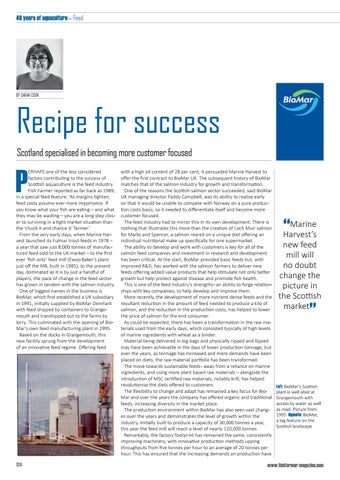40 years of aquaculture – Feed
BY SARAH COOK
Recipe for success Scotland specialised in becoming more customer focused
P
ERHAPS one of the less considered factors contributing to the success of Scottish aquaculture is the feed industry. Fish Farmer reported as far back as 1989, in a special feed feature: ‘As margins tighten, feed costs assume ever more importance. If you know what your fish are eating – and what they may be wasting – you are a long step closer to surviving in a tight market situation than the ‘chuck it and chance it’ farmer.’ From the very early days, when Marine Harvest launched its Fulmar trout feeds in 1978 – a year that saw just 8,000 tonnes of manufactured feed sold to the UK market – to the first ever ‘fish only’ feed mill (Ewos-Baker’s plant just off the M8, built in 1985), to the present day, dominated as it is by just a handful of players, the pace of change in the feed sector has grown in tandem with the salmon industry. One of biggest names in the business is BioMar, which first established a UK subsidiary in 1991, initially supplied by BioMar Denmark with feed shipped by containers to Grangemouth and transhipped out to the farms by lorry. This culminated with the opening of BioMar’s own feed manufacturing plant in 1995. Based on the docks in Grangemouth, this new facility sprung from the development of an innovative feed regime. Offering feed
124
Biomar.indd 124
with a high oil content of 28 per cent, it persuaded Marine Harvest to offer the first contract to BioMar UK. The subsequent history of BioMar matches that of the salmon industry for growth and transformation. One of the reasons the Scottish salmon sector succeeded, said BioMar UK managing director Paddy Campbell, was its ability to realise early on that it would be unable to compete with Norway on a pure production costs basis, so it needed to differentiate itself and become more customer focused. The feed industry had to mirror this in its own development. There is nothing that illustrates this more than the creation of Loch Muir salmon for Marks and Spencer, a salmon reared on a unique diet offering an individual nutritional make up specifically for one supermarket. The ability to develop and work with customers is key for all of the salmon feed companies and investment in research and development has been critical. At the start, BioMar provided basic feeds but, with improved R&D, has worked with the salmon farmers to deliver new feeds offering added value products that help stimulate not only better growth but help protect against disease and promote fish health. This is one of the feed industry’s strengths - an ability to forge relationships with key companies, to help develop and improve them. More recently, the development of more nutrient dense feeds and the resultant reduction in the amount of feed needed to produce a kilo of salmon, and the reduction in the production costs, has helped to lower the price of salmon for the end consumer. As could be expected, there has been a transformation in the raw materials used from the early days, which consisted typically of high levels of marine ingredients with wheat as a binder. Material being delivered in big bags and physically ripped and tipped may have been achievable in the days of lower production tonnage, but over the years, as tonnage has increased and more demands have been placed on diets, the raw material portfolio has been transformed. The move towards sustainable feeds - away from a reliance on marine ingredients, and using more plant based raw materials – alongside the introduction of MSC certified raw materials, notably krill, has helped revolutionise the diets offered to customers. The flexibility to change and adapt has remained a key focus for BioMar and over the years the company has offered organic and traditional feeds, increasing diversity in the market place. The production environment within BioMar has also seen vast changes over the years and demonstrates the level of growth within the industry. Initially built to produce a capacity of 30,000 tonnes a year, this year the feed mill will reach a level of nearly 120,000 tonnes. Remarkably, the factory footprint has remained the same, consistently improving machinery, with innovative production methods upping throughputs from five tonnes per hour to an average of 20 tonnes per hour. This has ensured that the increasing demands on production have
Marine “Harvest’s
new feed mill will no doubt change the picture in the Scottish market
”
Left: BioMar’s Scottish plant is well sited at Grangemouth with access by water as well as road. Picture from 1995. Opposite: BioMar, a big feature on the Scottish landscape
www.fishfarmer-magazine.com
04/10/2017 15:45:30
